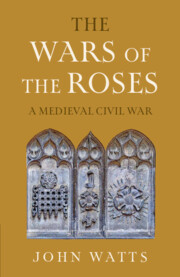
- Publisher:
- Cambridge University Press
- Online publication date:
- July 2025
- Print publication year:
- 2025
- Online ISBN:
- 9781009422185

This concise and interpretative book digs under the surface events of the Wars of the Roses to explore the underlying dynamics of a typical civil war. Beginning with a demonstration of why the well-worn storylines of the Wars are so misleading, it moves on to expose the pressure for reform that animated the conflict and helped to shape its outcomes. It continues by looking at the logics of division and the reasons why the Wars, once started, were so hard to resolve. It concludes by returning to debates long discussed by historians: the role of the economy in the conflict, and the interaction between English affairs and the politics of the British Isles and the near continent. Throughout, a central concern is to emphasise the fluidity and uncertainty of these civil wars: once authority broke down, anything could happen.
‘A brilliant, fascinating and profoundly thought-provoking analysis. The new light John Watts sheds on the Wars of the Roses from comparative and structural perspectives will shape debate about the fifteenth century for a long time to come.’
Helen Castor - author of The Eagle and the Hart: The Tragedy of Richard II and Henry IV
‘A masterwork of medieval political history, Watts’s thought-provoking meditation on the socio-political structures of England and its neighbours and the processes of division and distrust that led inexorably to conflict is an instant classic.’
Justine Firnhaber-Baker - University of St Andrews
‘In this extraordinary book, a model of comparative historical writing about a fifteenth-century civil war, John Watts manages not only to make sense of the Wars of the Roses, but to explain how and why they matter in our own age of uncertainty.’
Christian Liddy - Durham University
 Loading metrics...
Loading metrics...
* Views captured on Cambridge Core between #date#. This data will be updated every 24 hours.
Usage data cannot currently be displayed.
The PDF of this book is known to have missing or limited accessibility features. We may be reviewing its accessibility for future improvement, but final compliance is not yet assured and may be subject to legal exceptions. If you have any questions, please contact accessibility@cambridge.org.
Allows you to navigate directly to chapters, sections, or non‐text items through a linked table of contents, reducing the need for extensive scrolling.
Provides an interactive index, letting you go straight to where a term or subject appears in the text without manual searching.
You will encounter all content (including footnotes, captions, etc.) in a clear, sequential flow, making it easier to follow with assistive tools like screen readers.
You get concise descriptions (for images, charts, or media clips), ensuring you do not miss crucial information when visual or audio elements are not accessible.
You get more than just short alt text: you have comprehensive text equivalents, transcripts, captions, or audio descriptions for substantial non‐text content, which is especially helpful for complex visuals or multimedia.
You gain clarity from ARIA (Accessible Rich Internet Applications) roles and attributes, as they help assistive technologies interpret how each part of the content functions.